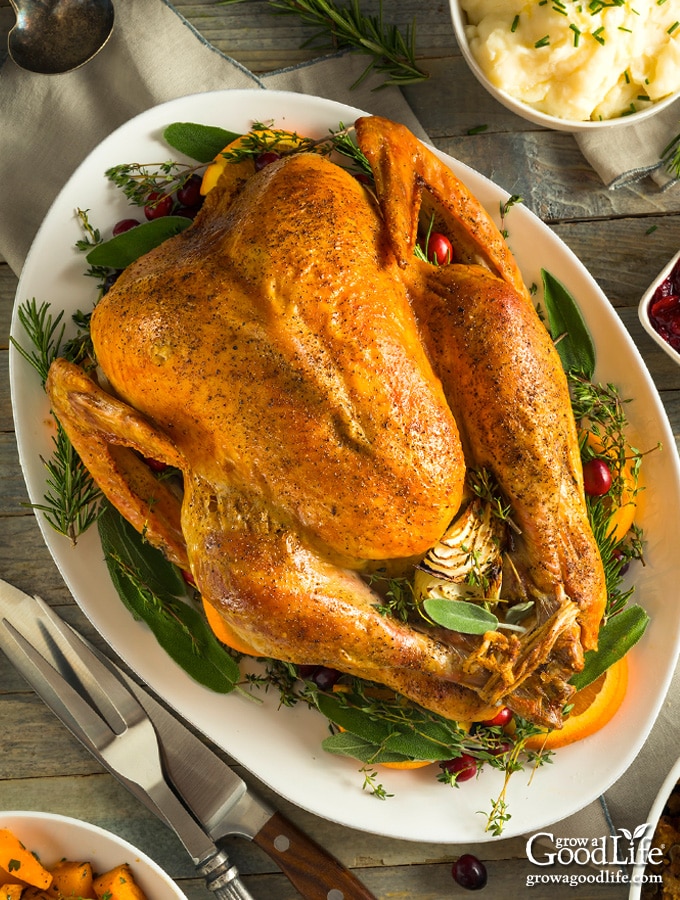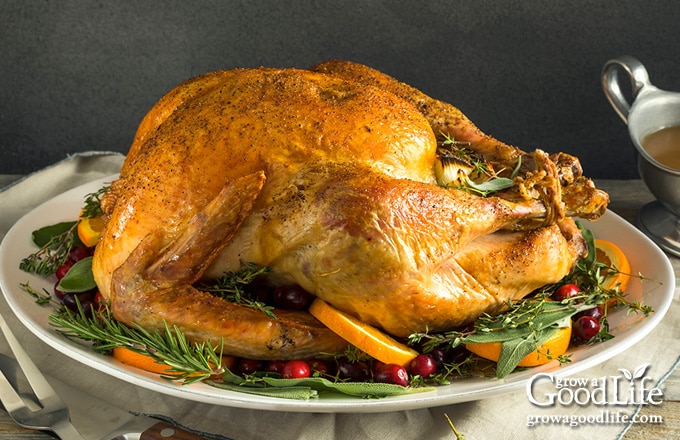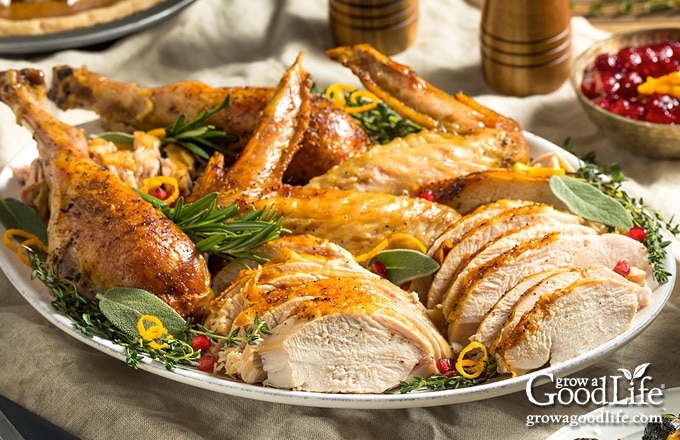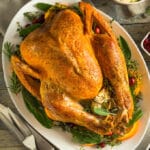Roasted Turkey with Italian Sausage Stuffing
This post may contain affiliate links, which means that I may receive a commission if you make a purchase using these links. As an Amazon Associate I earn from qualifying purchases.
Whether you are cooking for a crowd or a small family gathering, this simple roasted turkey with Italian sausage stuffing recipe is a delicious way to cook the perfect bird for your holiday meal. Learn how to roast a turkey with this easy recipe, plus tips to organize the big day.

Growing up, Thanksgiving was held at our home each year and the entire family would come over for dinner. My mother would prepare and roast the turkey, make the stuffing, mashed potatoes, vegetables, salad, and gravy. We would offer help, but knew she really didn’t want anyone in her kitchen while she prepared the meal.
After the main meal was over, we gorged ourselves on leftovers for days…hot turkey sandwiches with warm gravy soaked bread, turkey soup with leftover vegetables and noodles, piping hot turkey pot pies, and cold turkey sandwiches layered with cranberry sauce and stuffing. Mmmm…
When I moved away, I still rejoined the family for Thanksgiving, but missed out on the leftovers. I began roasting my own turkey the weekend after the holiday so we could have our own meal with plenty of leftovers, and bones to make turkey stock.
Since my mother prepared the meal herself, I had to learn how to do it on my own. I had a lot of successes and failures, including forgetting to remove the bag of giblets, not allowing enough time for the turkey to thaw, and plenty of dry, overcooked turkeys that required lots of gravy.
There are so many ways to cook a turkey for a holiday meal that it can be overwhelming, especially for first timers. You have your food channel chefs, food bloggers, and family offering advice that can be conflicting. Do you roast, grill, or deep fry? I suggest closing out all the noise and focusing on one method at a time. Roasting a turkey is a great place to start.
It can be intimidating, but this simple roasted turkey with Italian sausage stuffing is an easy recipe that I settled on over the years because it comes out delicious every time. I hope you will give it a try.

Tips for Roasting a Turkey for a Crowd
Roasting a turkey is pretty easy, but you do need to plan ahead. It can take days for a frozen turkey to defrost, and several hours to roast. Purchase your turkey ahead of time and keep it in the freezer until the week of your meal.
If you are normally the guest to Thanksgiving meals, but find yourself cooking this year, here are tips for a successful meal.
Determining the Size of Your Turkey
When choosing a turkey to serve to a crowd, plan on about 1.5 pounds per person.
We have a small family gathering on Thanksgiving, so I aim for a medium sized bird, around 12 pounds, which is plenty for 8 people.
I prefer roasting smaller turkeys. They are much easier to maneuver around the kitchen, thaw out faster, take up less space in the refrigerator, and they roast quicker in the oven than bigger birds.
If our gathering is larger, or if I want to hand out a lot of leftovers after the meal, I will roast two turkeys at the same time. If you go this route, check your oven for spacing to be sure there is enough room to accommodate two roasting pans.
Since the oven will be full, consider cooking your side dishes ahead of time and reheating in the oven while the turkey sets.
Use a Covered Roasting Pan
The key to achieving a moist turkey is to keep it covered during most of the cooking time. This is most easily achieved by using a roaster with a tight fitting lid.
Yes, you read that correctly. Most advice given for roasting turkey says to cook uncovered for a nice brown skin. However, this will rob your turkey of the moisture it needs to remain juicy. It will simply evaporate, and you will need to replenish water during cooking.
If you keep the cover on the roasting pan, it will hold in the moisture and even self-baste the turkey for you. Moisture evaporates from the bottom of the pan as steam, rises towards the lid, collects, and then drips back down on the turkey.
You don’t need anything fancy or expensive. I use a simple oval-shaped enameled roaster with a tight fitting lid. Uncover the turkey for 30 minutes at the end of the cooking time so the skin has a chance to get crispy.
An elevated roasting rack lifts the turkey off the bottom of the pan and helps the turkey cook evenly, while the pan collects the drippings for basting and making gravy. If you don’t have a rack, you can layer carrots, onions, and celery on the bottom of the pan, and place the bird on top to elevate it a bit.
Defrost the Turkey Safely
Turkeys need to be kept at a low temperature when thawing to prevent the growth of harmful bacteria.
Thaw in the Refrigerator: The safest way to defrost a frozen turkey is in the refrigerator. This allows the turkey to remain at a steady, cool temperature. Plan on a full day (24-hours) per 5 pounds of bird. So if your frozen turkey is 12 pounds, you will need 3 days to thaw completely.
To defrost a frozen turkey, keep the wrapping on, place it in a large prep bowl or rimmed roasting pan in case it leaks, and thaw in the refrigerator. Once the turkey is thawed, it is safe to keep in the refrigerator for another 2 days.
Defrost in Cold Water: Thawing a turkey in cold water is faster than letting it defrost in the refrigerator. However, you need to be available to change the water every 30 minutes so it stays cool. Plan on about 30 minutes for every pound of turkey. So a 12-pound bird will take about 6 hours to thaw completely in cold water.
To defrost using the cold water method, keep the wrapping on the turkey and submerge it completely in cold water. You can use your kitchen sink, a clean, 5-gallon bucket, or a cooler. Every 30 minutes, drain the water and replace it with fresh cold water. You will need to cook the turkey immediately after thawing.
I often use a combination of these two methods. I will thaw in the fridge for a few days, and then finish in cold water on Thanksgiving morning.
- How to Thaw a Turkey – USDA
Keep Everything Clean
This is the most important thing to remember. Keep everything clean so you do not spread bacteria around your kitchen. The USDA recommends you don’t rinse the turkey. Cooking the turkey properly will kill any bacteria that may be present.
“Do not wash or rinse your raw turkey. You should avoid washing or rinsing a turkey before cooking. Juices can transfer bacteria onto kitchen surfaces, other foods and utensils. If you must wash or rinse your turkey because of brining or other marinating process, be sure to thoroughly clean and then sanitize all kitchen surfaces to eliminate the risk of cross-contamination.” ~ USDA
Instead, get your roasting pan ready. Place the fully wrapped turkey in a large plastic bag, cut the wrapper, lift the turkey out of the wrapper, let any extra liquid drain into the plastic bag, and then place the turkey directly into the roasting pan. Discard the bag.
Remember to wash your hands well with warm soapy water each time you touch the turkey.
Use a Food Thermometer
The only way to tell if a turkey is cooked completely is to check that the internal temperature is at least 165˚F. That is the USDA recommended temperature for cooked turkey.
If you are cooking a stuffed turkey, the internal temperature of the stuffing must also reach 165˚F, which means that the turkey may end up a bit higher. The turkey will continue to cook for several minutes after you take it out of the oven. That’s ok.
Digital Probe Thermometer: If you use an oven-proof digital probe thermometer, you will be able to monitor the temperature without opening the oven door. These work by sticking the probe into the turkey, placing the roaster in the oven, and snaking the cord outside of the oven to attach to the display. It will show the temperature as the turkey cooks. You can also set an alarm to ring once the temperature is reached.
Instant Read Thermometer: Don’t rely on just the probe thermometer to test the temperature. In addition, use an inexpensive instant read thermometer to check various areas of the bird to be sure it is done, and to stick into the stuffing.
Things to Do the Day Before
You will have only 30 minutes between the time the turkey comes out of the oven, and rests before carving. By then your family and guests will have arrived hungry. The more side dishes you have ready ahead of time, the easier your day will be.
Consider making your salad, preparing the vegetables, baking pies and dinner rolls several days before the big meal and reheat right before serving as the turkey rests.
Pre-Cook Your Side Dishes: Many side dishes can be prepared ahead of time and warmed right before dinner.
Have Prepared Turkey Stock: Delicious gravy begins with homemade turkey stock. Making turkey or poultry stock ahead of time will ensure you will have plenty to flavor the stuffing and make the gravy without dipping into the hot roasting pan.
If you don’t have homemade stock on hand, use store bought broth or stock. Look for low sodium options and taste before adding seasoning.
Plan the Dinner Time, and then be Flexible: Plan on placing the turkey in the oven at least four hours before everyone sits down for the meal. You can estimate the time, but the turkey will decide when the meal is ready.
Most often, the actual roasting time will vary depending on your oven, how cold your turkey is when you begin, and how many times you open the oven while the turkey is roasting. It may be a little sooner or a little later. Have plenty of drinks and appetizers for your guests to keep them occupied.
Cooking the Turkey
If you are stuffing your turkey, always fill just before placing the bird in the oven. If you choose not to stuff your turkey, place the stuffing in a large baking dish and refrigerate until you are ready to bake it.
You can also make the stuffing a day ahead of time and refrigerate it, but don’t stuff until the turkey is ready to go in the oven to prevent bacteria from growing.
Estimate about 12-15 minutes of roasting time per pound for stuffed turkeys, so about 3 to 4 hours for a 12-pound turkey, including resting time.
In this recipe, the turkey starts out at a high heat for the first 30 minutes. This helps to warm the bird quickly, tightens the skin, and seals in the juices.
Then the heat is reduced, and the turkey is roasted until the internal temperature reaches 165˚F in all areas, including the thick parts of the thighs, wings, and deep into the stuffing.
Use your instant read thermometer to check all areas. If everything measures between 165˚F and 185˚F, remove the turkey from the oven, cover it, and let it rest for 30 minutes.
Letting the turkey rest for half an hour after it comes out of the oven is an important part of the roasting process. As the turkey roasts, the juices transfer to the outer flesh near the skin. While the turkey rests, the juices redistribute, resulting in moist, succulent meat.
Don’t Forget the Sides
While your turkey is resting is the perfect opportunity to get the side dishes cooked or warmed up if you precooked them ahead of time.
- Make the turkey gravy
- Boil the potatoes for Fluffy Mashed Potatoes
- Warm precooked side dishes in the oven
- Pull out the salad and dressings
- Don’t forget the cranberry sauce
- Warm the rolls
- Don’t forget to save the drippings from the pan and the turkey bones to make more turkey stock and freeze it for later

Roasted Turkey with Italian Sausage Stuffing
Ingredients
For the Stuffing:
- 2 loaves bread cut into 1/2 inch cubes (about 2 pounds)
- 1 pound sweet Italian sausage bulk or removed from casings
- 1 large onion finely diced
- 3 ribs celery finely diced
- 6 cloves garlic finely minced
- 2 tablespoons chopped fresh sage or 2 teaspoons dried
- 1 tablespoon chopped fresh parsley or 1 teaspoons dried
- 1/2 teaspoon chopped fresh oregano or 1/8 teaspoon dried
- 1/2 teaspoon chopped fresh thyme or 1/8 teaspoon dried
- 1/4 teaspoon kosher salt
- 1/8 teaspoon pepper
- 3 tablespoons unsalted butter
- 6 cups turkey stock divided
For the Turkey:
- 12 pound turkey (fully defrosted)
- 2 large carrots cut in half
- 1 large onion cut into wedges
- 4 tablespoons unsalted butter melted
- 1 tablespoon poultry seasoning
- 2 tablespoons corn starch
- salt and pepper
- water
Instructions
Make the Stuffing:
- Preheat the oven to 350˚F. Cut the bread cut into 1/2 inch cubes. Spread the cubes on baking sheets and bake in the oven until toasted, about 15 minutes. Skip this process if you are using store bought stuffing cubes.
- Break up and add the sausage to a large skillet. Cook over medium heat until the sausage is brown, about 10 minutes. Reserve about 1 tablespoon of fat, and drain the rest.
- Add the onion, celery, and garlic to the pan, and cook until softened, about 5 minutes.
- Add the sage, parsley, oregano, thyme, salt, pepper, and butter to the skillet and stir to combine. Turn off the heat once the butter is melted.
- Place the toasted bread cubes into a large bowl. Add the sausage mixture, and 2 cups of turkey stock. Stir to combine.
Prepare the Turkey:
- Increase the oven temperature to 450˚F.
- Place the roasting rack into the bottom of the roasting pan.
- Place the fully wrapped turkey in a large plastic bag, cut the wrapper, lift the turkey out of the wrapper, let any extra liquid drain into the plastic bag, and then place the turkey directly into the roasting pan, breast side up.
- Remove the neck and giblets from the neck and main cavity. Place these into the bottom of the roasting pan around the turkey. Discard the wrappings and wash your hands well each time you handle the turkey before touching anything else in your kitchen.
- Spoon about 4 cups of the stuffing into the main and neck cavities. The stuffing should be loose and have plenty of space to expand.
- Add the remaining stuffing into a baking dish, cover and refrigerate to cook later.
- Tie the legs together with kitchen string, tuck the neck flap under the bird and secure with toothpicks if it is stubborn. Fold the wing tips under turkey. It doesn't have to be perfect.
- Rub the turkey with melted butter, and season well with poultry seasoning, salt, and pepper.
- Scatter the carrots and onion wedges around the bird.
- Add 2 cups of water to the bottom of the roasting pan.
- Place the thermometer probe into the thickest part of the thigh, and cover the roaster.
Roast the Turkey:
- Place the roasting pan into the preheated oven. Pull the attached thermometer cord outside the oven door, and set it to sound an alarm when the turkey has reached 165˚F.
- Cook the turkey for 30 minutes at 450˚F. Lower the oven temperature to 375˚F, and continue roasting the turkey until the internal temperature reaches 165˚F, about 3 hours.
- Uncover the roasting pan for the last 30 minutes so the skin browns. Baste the turkey with the juices from the bottom of the pan, and place it back into the oven uncovered.
- Once the thermometer reads 165˚F, remove the turkey from the oven and check the temperature in several areas using the instant read thermometer. Check the thick part of both thighs, the wings, and push the thermometer probe deep into the stuffing to be sure all areas are at least 165˚F.
- Cover the roasting pan, and let the turkey rest for 30 minutes. Prepare your additional stuffing, gravy, and side dishes while the turkey rests.
Bake the Stuffing:
- Drizzle 1 cup of turkey stock over the remaining stuffing in the baking dish, and bake uncovered until heated through and crispy on top, about 30 minutes.
Make the Gravy:
- Add 3 cups of turkey stock to a medium saucepan.
- Whisk together 1/4 cup of cold water and 3 tablespoons of corn starch, and add to the saucepan.
- Bring the pan to a boil over medium heat and cook while stirring until thickened, about 5 minutes. Season with salt and pepper to taste, reduce the heat, and keep warm until you are ready to serve.
Serve the Turkey:
- Spoon the stuffing from the cavity into a serving bowl, carve the turkey, and serve with your side dishes.
- Save the drippings from the pan and turkey bones to make more turkey stock and freeze it for later.
- Refrigerate leftovers within two hours of being served. Once refrigerated, they should be consumed within three to four days.
Notes
Nutrition
You May Also Like:


